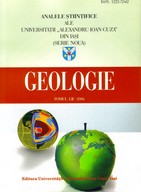
English title
- SERIA
GEOLOGIE (AUI-G) - |

|
| Log in New account |
| Home | Main Page | Guide for Authors | Peer Review | New Articles | Events | Archive | Index | Contact us |

|
Article The composition and source of the raw material of two stone axes of Late Bronze Age from Neamț County (Romania) - A Raman study
Nicolae Buzgar - “Al. I. Cuza” University of Iaşi, Department of Geology, Archaeoinvest Platform, Scientifical Research Laboratory, 20A Carol I Blv., 700505 Iaşi, Romania Andrei Ionuț Apopei - “Al. I. Cuza” University of Iaşi, Department of Geology, Archaeoinvest Platform, Scientifical Research Laboratory, 20A Carol I Blv., 700505 Iaşi, Romania Vasile Diaconu - The History & Ethnography Museum of Târgu Neamț, Ștefan cel Mare Street 37, 615200 Tg. Neamț, Romania Andrei Buzatu - “Al. I. Cuza” University of Iaşi, Department of Geology, Archaeoinvest Platform, Scientifical Research Laboratory, 20A Carol I Blv., 700505 Iaşi, Romania View abstract as pdf file | View full article as pdf file Abstract: Two stone axes of Late Bronze Age from Moldova region (Romania) have been studied by Raman spectroscopy. The first axe (A1) belongs to the archaeological site Vînători (Neamț county). From a petrographic viewpoint, the sample is an andesite with pyroxenes and amphiboles, having a porphyric texture. The Raman study reveals the presence of plagioclase feldspar, pyroxene, hornblende, hematite and prehnite. The second artefact (A2) belongs to Topolița archaeological site (Grumăzești, Neamț county). Petrographically, the sample is a meladiorite with hornblende. Besides plagioclase and amphibole, Raman spectroscopy also identified titanite, quartz, epidote and hematite. On the surface it has a thin and transparent layer of black carbon. The Raman spectral lines of black carbon corespond to those of the highly disordered graphite due to the broaden D and G peaks and also due to the inclusion of D2 band (~1630 cm-1) in the broad G band (~1600 cm-1).The black carbon uniform layer of the axe A2 was achieved by firing in a reducing atmosphere. Keywords: artefacts, stone axes, Raman spectroscopy, black carbon laye |
copyright © 2024 Department of Geology |